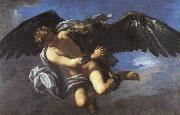
|
Anton Domenico Gabbiani
|
|||
|
|
|||
| 1652-1726 Italian Anton Domenico Gabbiani Gallery Italian painter. He first trained with the Medici court portrait painter Giusto Suttermans and then with the painter Vincenzo Dandini. On 20 May 1673 he arrived in Rome, where he studied for three years under Ciro Ferri and Ercole Ferrata at the Accademia Fiorentina. He responded in particular to the paintings of Pietro da Cortona and Carlo Maratti who were both to be important influences on him. Though not precocious, Gabbiani became one of the most noted painters from the Accademia. After a period in Venice (1678-9) with the portrait painter Sebastiano Bombelli, he was in Florence in 1680. By 1684, the year in which he executed an Annunciation (destr.) for the Palazzo Pitti, he was an independent painter. His first important public commission, the St Francis de Sales in Glory (1685) for the church of SS Apostoli, Florence (in situ), shows the influence of Maratti in its grandiose composition and that of Dandini in the treatment of figures. In Prince Ferdinando de Medici Gabbiani found a particularly loyal patron, and he painted his portrait, Ferdinando de Medici and his Musicians (c. 1685; Florence, Pitti). One of the works executed for Ferdinando was possibly a portrait of his sister, which Chiarini has identified with the painting of Anna Maria Luisa de Medici (c. 1685; Florence, Pitti). Further works from this period are the group portrait of Three Musicians (Florence, Pitti) at Ferdinando court and a Group of Courtiers (1685-90; Florence, Uffizi). | |||
|
|
|||
|
The Rape of Ganymede Anton Domenico Gabbiani1.jpg Painting ID:: 1292 |
1700 Galleria degli Uffizi, Florence | ||
|
|
|||
|
Peter Paul Rubens
|
|||
|
|
|||
| Flemish Baroque Era Painter, 1577-1640 Peter Paul Rubens (June 28, 1577 ?C May 30, 1640) was a prolific seventeenth-century Flemish Baroque painter, and a proponent of an exuberant Baroque style that emphasized movement, color, and sensuality. He is well-known for his Counter-Reformation altarpieces, portraits, landscapes, and history paintings of mythological and allegorical subjects. In addition to running a large studio in Antwerp which produced paintings popular with nobility and art collectors throughout Europe, Rubens was a classically-educated humanist scholar, art collector, and diplomat who was knighted by both Philip IV, king of Spain, and Charles I, king of England. Rubens was a prolific artist. His commissioned works were mostly religious subjects, "history" paintings, which included mythological subjects, and hunt scenes. He painted portraits, especially of friends, and self-portraits, and in later life painted several landscapes. Rubens designed tapestries and prints, as well as his own house. He also oversaw the ephemeral decorations of the Joyous Entry into Antwerp by the Cardinal-Infante Ferdinand in 1635. His drawings are mostly extremely forceful but not detailed; he also made great use of oil sketches as preparatory studies. He was one of the last major artists to make consistent use of wooden panels as a support medium, even for very large works, but he used canvas as well, especially when the work needed to be sent a long distance. For altarpieces he sometimes painted on slate to reduce reflection problems. His fondness of painting full-figured women gave rise to the terms 'Rubensian' or 'Rubenesque' for plus-sized women. The term 'Rubensiaans' is also commonly used in Dutch to denote such women. | |||
|
|
|||
|
The Rape of Ganymede new25/Peter Paul Rubens-663749.jpg Painting ID:: 85255 |
Date 1611(1611) Medium Oil on canvas cjr | ||
|
|
|||
|
Also Buy::. For Following Paintings / Artists / Products, Please Use Our Search Online: |









